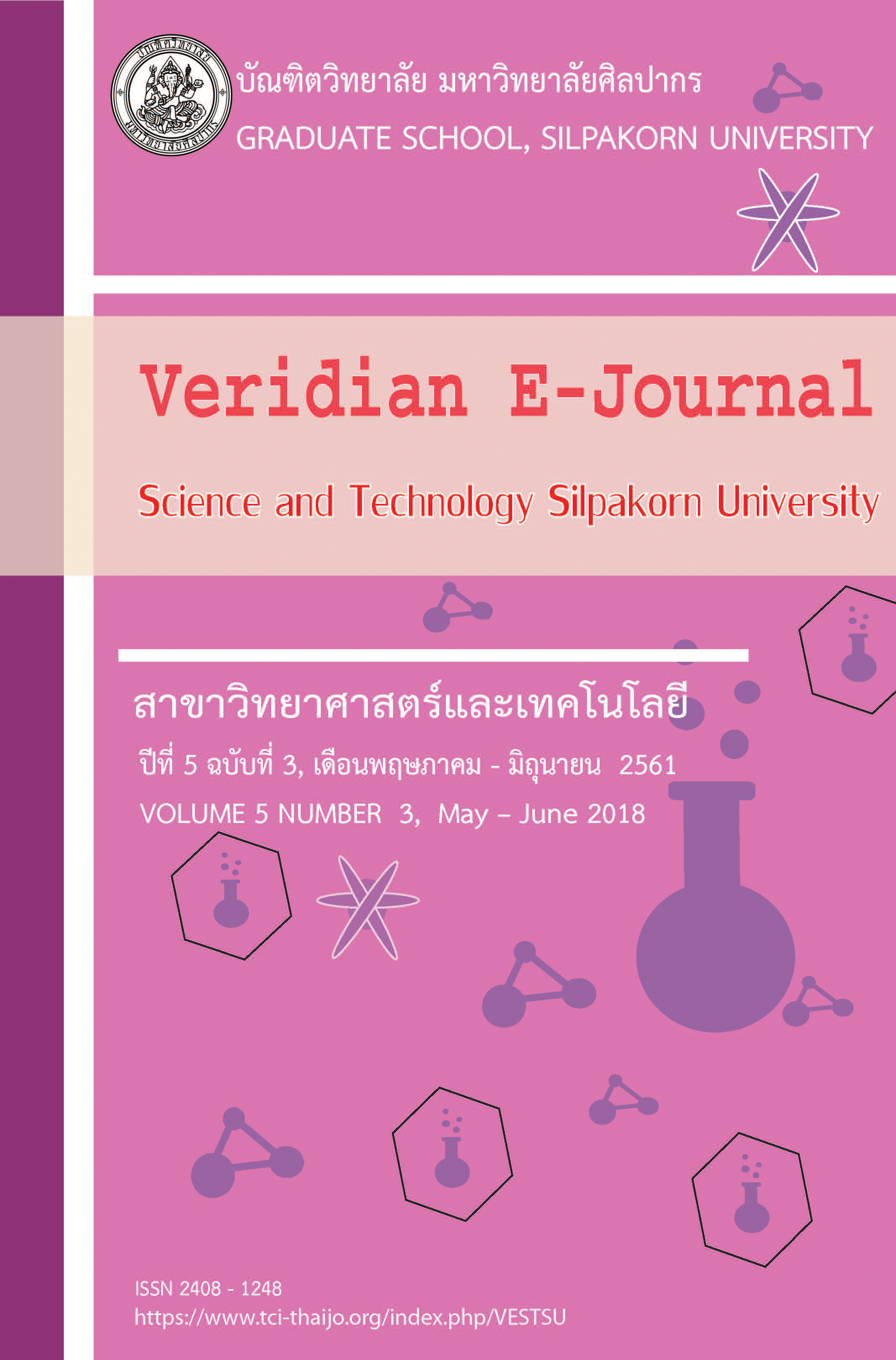การประเมินรอยเท้าคาร์บอนขององค์กร กรณีศึกษาของภาควิชาวิทยาศาสตร์สิ่งแวดล้อม คณะวิทยาศาสตร์ มหาวิทยาลัยศิลปากร (Assessing organizational carbon footprint: a case study for department of environmental science, faculty of science, Silpakorn University)
Main Article Content
Abstract
การประเมินรอยเท้าคาร์บอนขององค์กร คือ การวัดปริมาณรวมของก๊าซเรือนกระจกในรูปของคาร์บอนไดออกไซด์ ที่ถูกปลดปล่อยจากกิจกรรมขององค์กรทั้งทางตรง (direct) และทางอ้อม (indirect) ซึ่งจะทำให้ทราบถึงข้อมูลการปล่อยและดูดกลับก๊าซเรือนกระจกที่ปล่อยจากการดำเนินงานจากกิจกรรมต่างๆ ขององค์กรอย่างเป็นระบบ และเป็นจุดเริ่มต้นที่จะนำไปสู่การสร้างแนวทางในการบริหารจัดการเพื่อลดการปล่อยก๊าซเรือนกระจกได้อย่างมีประสิทธิภาพมากยิ่งขึ้น องค์กรการศึกษาโดยเฉพาะอย่างยิ่งมหาวิทยาลัย ไม่ได้เป็นหน่วยงานที่เป็นศูนย์กลางการศึกษาในระดับอุดมศึกษาที่มุ่งเน้นเพียงการเรียนการสอนเพียงอย่างเดียว หากแต่เป็นหน่วยงานขนาดใหญ่ที่ประกอบไปด้วยกิจกรรมที่มีความหลากหลายที่เกี่ยวข้องกับการปลดปล่อยก๊าซเรือนกระจก เช่น การใช้ยานพาหนะ การใช้อุปกรณ์ไฟฟ้า กระดาษ สารเคมีบางชนิด การเผาไหม้ เป็นต้น การศึกษาในครั้งนี้ได้ใช้กรณีศึกษาของภาควิชาวิทยาศาสตร์สิ่งแวดล้อม คณะวิทยาศาสตร์มหาวิทยาลัยศิลปากร ในระยะเวลาการประเมิน 1 ปีการศึกษา (2559) โดยแบ่งขอบเขตการศึกษาออกเป็น 3 ขอบเขตตามข้อกำหนดในมาตรฐาน ISO/TR 14069: 2013 คือ การปลดปล่อยทางตรง การปลดปล่อยทางอ้อมจากการใช้พลังงาน (ที่ซื้อมา) และการปลดปล่อยทางอ้อมอื่นๆ โดยผลการศึกษาพบว่า การปลดปล่อยก๊าซเรือนกระจกรวมของภาควิชาใน 1 ปีการศึกษา มีค่ารวมเท่ากับ 237 tCO2-eq (ตันเทียบเท่าคาร์บอนไดออกไซด์) หรือคิดเป็น 1.29 tCO2-eq ต่อคน โดยขอบเขตการปลดปล่อยในขอบเขตที่ 2 คือ การปลดปล่อยทางอ้อมรวมจากการใช้พลังงานไฟฟ้า มีสัดส่วนในการปลดปล่อยมากที่สุดเมื่อเปรียบเทียบกับขอบเขตอื่นคิดเป็นร้อยละ 58.1 ของการปลดปล่อยทั้งหมดซึ่งส่วนใหญ่มาจากการใช้อุปกรณ์ปรับอากาศและอุปกรณ์เครื่องใช้ไฟฟ้าในห้องปฏิบัติการและเพื่อการทำวิจัย รองลงมาคือขอบเขตที่ 3 การปลดปล่อยทางอ้อมจากกระบวนการอื่นๆ คิดเป็นร้อยละ 41.2 โดยมีสัดส่วนหลักมาจากการเดินทางไป-กลับของนักศึกษาและบุคลากร
Assessment of carbon footprint of an organisation is an environmental method to measure total emission of greenhouse gases in the form of carbon dioxide equivalent from organisation’s activities in both direct and indirect ways. As a result, the assessment reveals an inventory of operating activities relating to greenhouse gas emissions and absorptions and the result can be used as an initiative to manage and reduce greenhouse gas emission of an organisation more efficiently. Academic institution particularly university is not only an academic centre for high education level, but also be a large-scale organisation consisted of a variety of activities associated with greenhouse gas emissions, e.g. energy consumption, transportation, incineration, use of some chemicals, etc. In this study, department of environmental science, faculty of science, Silpakorn University was selected to be a case study. Activity-related emissions of the department were divided into 3 scopes according to ISO/TR 14069: 2013: 1) direct emissions, 2) indirect emissions from purchased energy and 3) other indirect emissions. The results found that total emissions of greenhouse gases of the department assessed in one academic year (2016) was 237 tCO2-eq (tonnes CO2-equivalent) or 1.29 tCO2-eq per capita (total emissions divided by a number of department’s staff members and students). The emissions in scope 2, indirect emissions from purchased energy, showed the largest portion, 58.1 percent of total emissions, contributed mainly by uses of air conditioning equipment together with research and laboratory equipment. The emissions in scope 3, other indirect emissions, played a less important role accounted for 41.2 percent of total emissions. The main source of emissions was from commutes of staff members and students.

